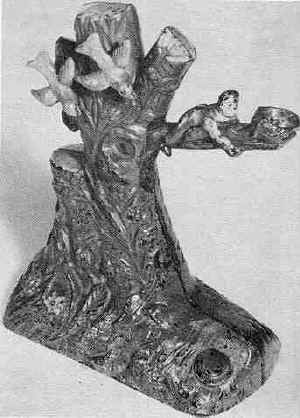Boy Robbing Bird’s Nest Bank
by F.H. Griffith - HOBBIES Magazine - January, 1963
 Of particular interest are certain of the mechanical banks that
have as their theme various forms of object lessons. These object lessons vary, some are
instructive in teaching a child what to do and others are constructive in showing or
demonstrating what not to do. The Boy Robbing Bird’s Nest is an excellent example of
the latter type, and is our choice as No. 110 in the numerical classification. All the
mechanical banks were made to encourage the habit of saving in an amusing or entertaining
fashion and were, of course, in most cases a toy as well as a savings device. Those such
as the Boy Robbing Bird’s Nest with the additional instructive feature are of
considerable interest and in a class of their own. Some of the other mechanical banks in
this same area of the instructive element are the Picture Gallery, Bank of Education and
Economy, Boys Stealing Watermelons, and Uncle Remus.
Of particular interest are certain of the mechanical banks that
have as their theme various forms of object lessons. These object lessons vary, some are
instructive in teaching a child what to do and others are constructive in showing or
demonstrating what not to do. The Boy Robbing Bird’s Nest is an excellent example of
the latter type, and is our choice as No. 110 in the numerical classification. All the
mechanical banks were made to encourage the habit of saving in an amusing or entertaining
fashion and were, of course, in most cases a toy as well as a savings device. Those such
as the Boy Robbing Bird’s Nest with the additional instructive feature are of
considerable interest and in a class of their own. Some of the other mechanical banks in
this same area of the instructive element are the Picture Gallery, Bank of Education and
Economy, Boys Stealing Watermelons, and Uncle Remus.
The Boy Robbing Bird’s Nest is a very attractive, well made mechanical bank and is an original creation of the outstanding designer, Charles A. Bailey. It was produced and marketed by the leading manufacturer of mechanical banks, the J. & E. Stevens Company of Cromwell, Conn., and when sold by them it was known as the "Tree Bank." No name appears on the bank itself and for some years now, for collecting purposes, it has been known as the Boy Robbing Bird’s Nest. This is more definitive of the bank itself and actually closer to the name originally planned for the bank by Bailey. The writer, as mentioned in the Hen And Chick Bank article (June, 1962), has Bailey’s original sketch of the Boy Robbing Bird’s Nest and the name "Robber Bank" appears on the base of the bank in this drawing. Obviously this was not a particularly appealing name and was subsequently discarded in favor of the more attractive, simple name, "Tree Bank." This did not, of course, detract from the obvious object lesson of what could happen to boys who would climb trees to steal bird’s eggs. As produced commercially the bank is practically identical in appearance to Bailey’s original sketch, with one exception. There is a large stick leaning against the tree in the drawing. This was probably intended to indicate that the boy on the limb had unsuccessfully tried to get the bird’s nest by using the stick before climbing the tree.
Leon Perelman is the owner of the fine specimen pictured and, as can be judged from the photograph, the bank is in excellent original condition. Mr. Perelman obtained the bank from an Eastern antique dealer a few years ago. The paint is in mint condition with colors as follows: The base is an overall green highlighted with gold. Pink flowers appear on the base, along with the boy’s gray hat. The tree is brown with greenish-silver vines climbing up the trunk, red berries appear on these vines. The two birds are yellow. The boy has an orange shirt, blue trousers, and brown shoes and hair. Three small white eggs are in the nest.
To operate the bank a coin is first placed in the provided slot. This slot runs vertically in the trunk and is located just under the branch which the boy is climbing. The coin when placed in the slot stays in place protruding somewhat from the trunk. The lever to operate the bank is located just below the bird on the left. When this lever is pressed down the entire branch of the tree, including the boy and bird’s nest, falls and hits against the trunk, striking the coin and knocking it into the bank. The action is good and very effective. To reset the bank for operation the branch is manually raised to the position as shown in the picture. The branch locks in place and stays there until the lever is again pressed.
There are no markings, dates or anything else on the bank. However, the bank speaks for itself, as it is so obviously Bailey’s work. This is substantiated, of course, by the original Bailey’s sketch in the writer’s possession. As to the date or period in which it was manufactured, this is established by a dated 1906 catalog of the J. & E. Stevens Company which pictures the bank. The Shoot The Chute Bank, another Bailey design, also appears in this catalog. Thus apparently both banks were put on the market about the same time.
